
Please email or share this article!

10 Fascinating Yacht Facts for Kids

When you think about a boat, what’s the first thing that comes to mind? For us, we think of tiny fishing boats that fishermen use to get the best catch of the day! However, you might not think of a yacht immediately. Yachts are some of the biggest boats in the world, and they can be found in most major oceans! In this article, we’re going to take a closer look at some fun and interesting facts about yachts, so let’s dive right into it.
10 Interesting Facts About Yachts
1. the word ‘yacht’ is dutch in origin. .
Did you know that the word ‘yacht’ has Dutch roots? It comes from the word jacht , which, when translated, means hunt. Before yacht came to mean what it does today, it also originally referred to a different type of boat. These boats were sailing vessels known for their speed and lightweight structure.

These boats were used by the Dutch Republic Navy to capture pirates and other naval criminals. Eventually, the boats that we now know to be called yachts got their names after Charles II visited the Netherlands, and came across jachten , and the same was anglicized and later stuck.
2. The idea of a yacht first came around in the 17th century.
It’s interesting to note that yachts were first conceptualized in the 17th century. This occurred when the royal advisors suggested building King James I of England’s son a sailing vessel that was purely for his pleasure and leisure. King James later became the first person to commission a yacht for his son, and in the years that followed, various other members of the royal family chose to have yachts built for themselves.
3. There are several different types of yachts.

Did you know that there are multiple types of yachts that serve varied purposes? These types include motor and sailing yachts, catamarans, fishing yachts, and even expedition yachts. Each of these yachts serves a different purpose, such as transporting goods, entertaining wealthy people, and competing in sailing contests.
4. Yachts can be constructed from different types of materials.
Although you might think that the average yacht is constructed with metal and glass, it might interest you to know that the earlier yachts used to be constructed with wood. However, when the 1960s rolled around, yachts were made from fiberglass. In the case of larger yachts that need to last for a longer time, they are made from stainless steel or aluminum. Some yachts are even made from fiber-reinforced plastic.
Check this article on Titanic facts.
5. Each yacht can have cabins of different sizes.
It’s interesting to note that based on the size of a yacht, it can have either two or more than two cabins. Smaller yachts sometimes have convertible berths that are used as a seating area during the day, and a cabin for sleeping at night.
6. Sailing and cruising yachts both serve very different purposes.

Although their names already explain how these yachts differ from each other, we’re going to explain further. Cruising yachts are generally built for leisure purposes and pleasure, which means that they aren’t built for speed or competition. However, sailing yachts are built to withstand all kinds of weather conditions and speed. They must be easy to steer and control, particularly when both the wind and water are strong and dangerous.
7. There are thousands of yachts spread across the world.
At present, more than 10,000 yachts are spread throughout the world. Over 5,300 of those yachts are close to 100 feet long.
8. Azzam is the biggest yacht in the world.

The Azzam yacht is actually considered to be a super-yacht! It was built by Lürssen Yachts, which is a German shipyard. It is 590 feet long, making it the longest and biggest yacht in the entire world. Its beam is around 68 feet, and its draft is 14.1 feet.
9. Many yacht crews live on the yachts throughout the year.
It’s no secret that being a yachter is a full-time career. However, it’s interesting to note that many yachters live on the boats they work on full-time, and serve the yacht’s owner throughout the year. However, although these jobs can be difficult, they are incredibly well-paying.
Read our article on the Sinking of the Lusitania Ship .
10. People in the United States own 23% of the world’s total yacht fleet.
Yacht owners in America make up a significant portion of the world’s total yacht fleet! It’s also interesting to note that these people in the States also own 23% of the superyachts in the world.
In this article, we examined some interesting and new facts about yachts. We were particularly interested to learn about the origins of these huge boats, and how they have evolved since they were invented. We hope that this article taught you something new, and that you enjoyed reading it. Did we miss out on a fun fact that you know about? Let us know in the comments below!
Your source for the latest news on yachts, boats and more. Read through our articles to find out how to compare boats and find the right fit for you!
10 interesting fun facts about boats that you did not know
Aug 05, 2020
less than a min

Boats are very interesting vessels. Here are some fun facts about boats that you might not have heard about.
- Good luck and back luck omens are different on a boat than on dry land. For instance, whistling on a boat is expected to bring upon strong winds and is therefore considered bad luck. Bananas on a boat are also seen as bad luck especially on fishing boats. It is thought that fish do not bite on a hook if there are bananas close by. Finding a cat on a boat on the other hand is considered good luck, even if it is a black cat. Cats eat rats and keep the boat clean and safe.
- The youngest person to sail around the world is Laura Dekker. She is a 14-year old that went off to sail around the world in 2012 and finished her trip 518 days later when she was 16.
- A party yacht has tripped over once as all the passengers moved to one side to have a better look at a nudist beach in Texas.
- A 2004 study has confirmed that joining a cruise ship after retirement is cheaper than retiring to a retirement home.
- The difference between a boat and a ship lies in its weight. If a vessel is over 500 tones then it is called a ship. A ship can also carry a boat.
- The first ship to reach America only had 40 people on board, including Christopher Columbus. It was the size of a bus and it did not exceed 70 feet.
- According to evidence found by several archeologists, boats have been used over 900.000 years ago.
- Americans own about 18 million boats today. Some of them are used for recreational purposes while others are commercial boats.
- Boats have a life expectancy. After that, they are not deemed safe or stable anymore. Usually, cargo ships that sail in the oceans can have a lifespan of 20 to 30 years. Sailboats are meant to be used for 30-40 years even if they are made of softer materials such as plywood or fiberglass.
- Vasa is a Swedish warship that is known for sinking in 1628 and being recovered in 1961. After spending centuries in the water, this boat was still completely intact and in good shape. It is actually the only vessel left from the 17th century. This boat now lies in the Vasa Museum of Stockholm which was built as a tribute to this ship. It is now one of Sweden’s most popular attractions. It receives almost 30 million tourists.
Explore TheBoatAPP to learn more interesting information about boats and their features. Discover how to maintain, manage, and preserve a boat through the complete database of TheBoatAPP. Become a boat master in no time!
You might like these too

Electric and Hybrid Boats – The Future of Sailing
Aug 23, 2022
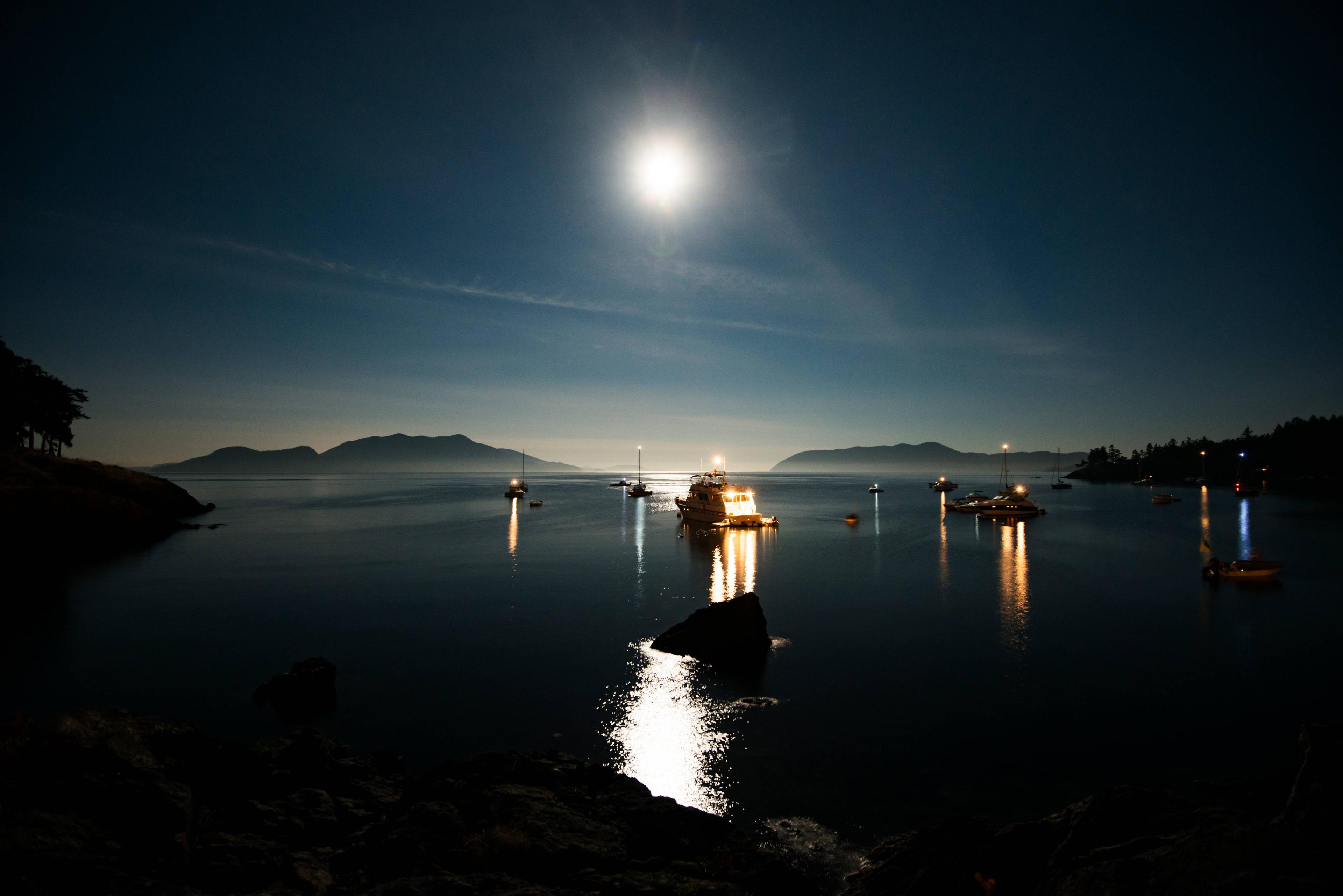
Boat navigation light types and functions

How Long does it Take to Sail Around the World
Oct 04, 2021
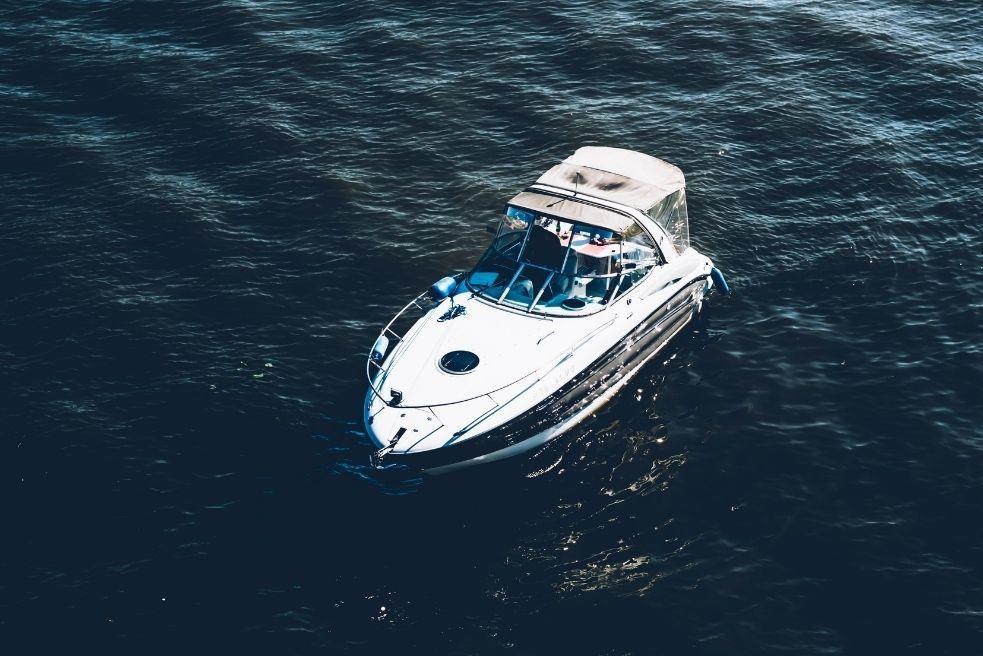
What are some Fun Things to Bring on a Boat
Oct 01, 2021
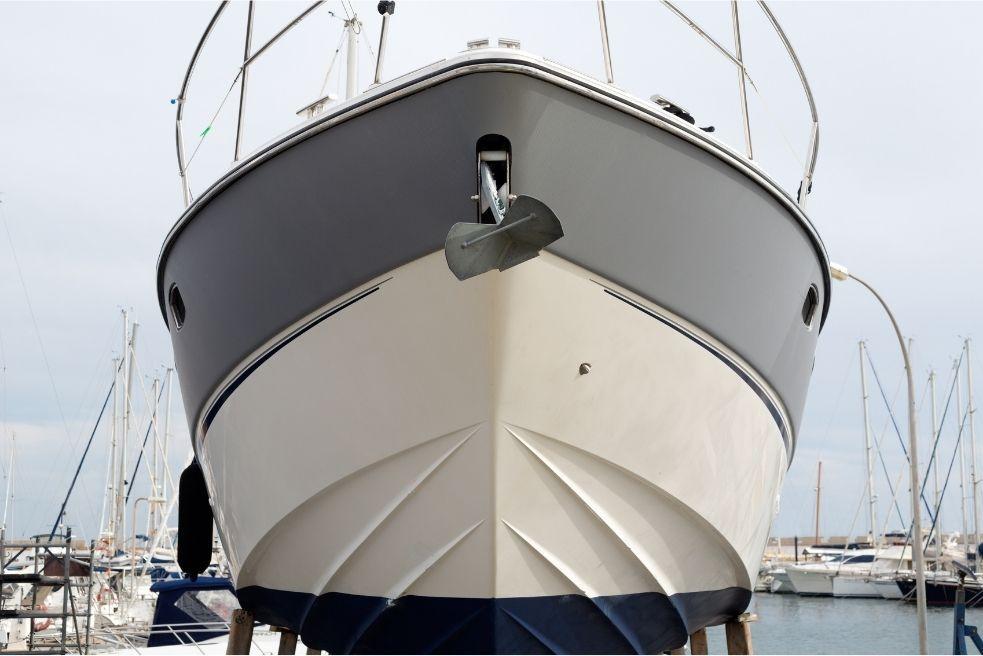
The Proper Term for the Forward End of a Boat
Sep 30, 2021
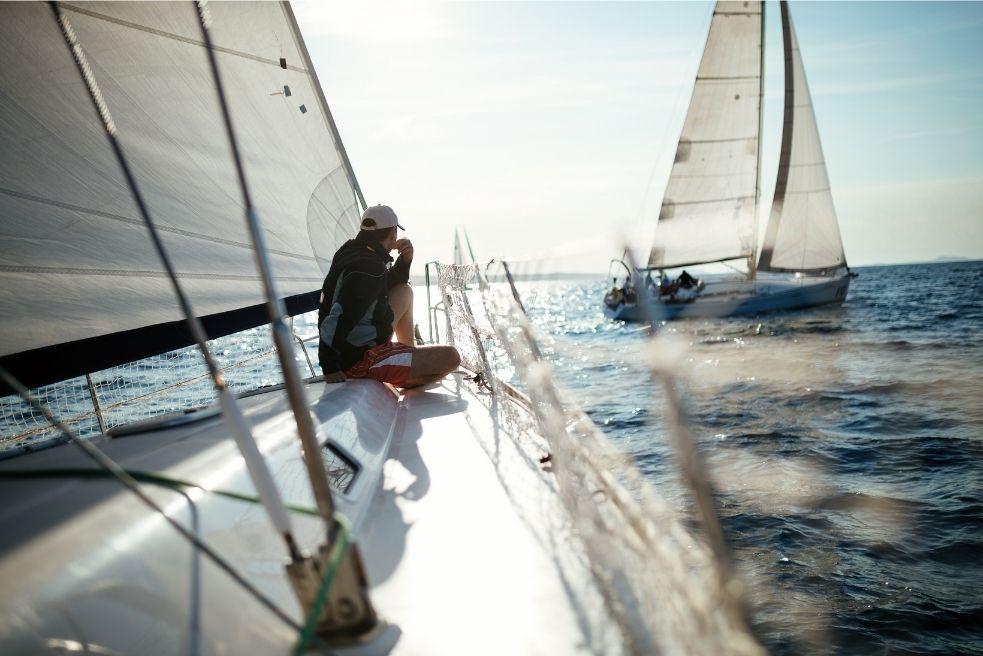
Regular Boat Maintenance Tasks You Should Always Do
Sep 17, 2021
25 Interesting Facts About Sailing You Probably Don't Know

Sailing is a very popular sport, and it has had a large influence on modern life. I've came across lots of interesting facts about sailing, and list them here.
With such a rich history there are many interesting stories to tell. It has shaped our language and the way we see the world today. Our society and free trade is built on the tradition of sailing.
So in this post I've listed all sorts of interesting sailing facts that I came across while researching the articles on this website. Most of them are beyond the obvious. Surely, the trade winds are named after the trade they facilitate? No, it's actually the other way around.
On this page:
1. sailboats are slow (but efficient), 2. trade is named after the trade winds, not the other way around, 3. sailing gives you access to places that are off-limits to tourists, 4. the ideal wind speed for sailing is between 8-12 knots, 5. historical sailboats are often misrepresented, 6. you can operate a 100' sailboat alone, 7. the youngest person to circumnavigate the world was 16-year old laura dekker, 8. feeling blue is originally a sailing term, 9. one of the best laser radial sailors is from the netherlands, 10. sailing has been a part of the olympics from 1896 onwards, 11. 'sonofagun' actually refers to your birthplace, 12. the average salinity of oceans is 3.5% - but it varies greatly, 13. the world-record sailing speed is 65.45 knots (75 mph), 14. you can sail for nearly 22,229 miles in a straight line, 15. the first person to circumnavigate the world alone was joshua slocum (1898), 16. the new york yacht club has one of the longest winning streaks in sports history, 17. the largest sailing yacht in the world is nearly 470' or 143 m long - or not, 18. sailing around the world westward is more difficult than eastward, 19. 'he's a loose cannon' ..., 20. the most popular sail rig is based off a moorish lateen rig, 21. the only 5-masted tall ship sunk because of its speed, 22. the smallest boat to sail around the world was 21 feet, 23. sailboats can sail faster than the speed of the wind, 24. the sailing flags originate from the dutch war efforts against the british, 25. the mightiest pirate was a female chinese prostitute.
The average sailboat cruises at about 4-6 knots, (4-7 mph or 7-11 km/h) and has a top speed of 9 knots (10 mph or 17 km/h). It's just not that fast. That isn't to say there aren't any quick boats: they can be incredibly fast. Especially the multihulls, which have to displace a lot less water. They can go up to 50 knots (almost 60 mph or 93 km/h).
Most sailboats are slow is because they are small (under 20') - and the hull speed is directly related to the length of the boat. Longer sailboats are faster.
So how is a sailboat able to go around the world in under 75 days? Well, they go on all day and night. Also, traveling on water allows you to go in straight lines more often than on land.
Want to know how far a sailboat can sail in a day ? Check out my other article on the average sailing distance in different conditions (new tab).
Our ancestors found that the Atlantic had very reliable wind roads. These roads were called trade winds, trade being the Middle English word for 'track' or 'path'. The trade winds were so important for the English fleet and economy that the name 'trade' became generally accepted to mean (foreign) commerce'.
If you want to learn how the trade winds work , I recommend to read my post on the Atlantic Crossing .
Did you know that there are a lot of small island that are off-limits to tourists? Some of these islands are real hidden gems, with exotic species, wonderful landscape, and authentic villages. There are no flights or cruises going there - but you can get there by boat.
It can be quite the experience to sign in to the island in a 40-year old ledger, with under 200 names in there.

The easiest wind to maneuver small and mid-sized boats is between 8-12 knots, while still being able to reach good speeds.
Anything between 5-8 knots is ideal for beginners that are trying to learn to sail. Anything under 5 knots gets tediously slow.
If you like to learn more about wind speeds, I really go into detail in my previous post Ideal Wind Speed for Sailing .
When we think of old skool sailboats (of the late Middle Ages for example), we often thing of large galleons and first rates. However, due to a flaw in the design of the hull, the ship builders weren't able to build large ships until the Renaissance.
The extended beams, running across the entire length of the ship, were too weak, so they would rot out. Large experimental ships would find an early sea grave when they split into two and sunk.
So the huge floating multi-level buildings with 100 cannons only started to be made in the Napoleonic era, when they figured out you could use cross beams to reinforce the hull.
People often ask me what the biggest boat is they can operate. You can actually operate a 100' sailboat by yourself - if you rig it the right way.
World-record holder François Gabart operated the 100-foot Trimaran MACIF by himself. However, it's not easy and you have to be experienced and mentally tough. Most sailors seem to stay under 35 foot.
Sailing alone is also called short-handed sailing, and you need a short-hand sailing rig. Typically this means lot's of automated systems, and all the sheets running to your cockpit, allowing you to operate the sails while steering at the same time.
The hardest part of sailing by yourself may actually be the docking. Some marinas even offer a special service to help you with that, lending a helping hand. If you are inclined to sail alone (or don't have any friends), you should definitely consider switching to a marina that provides this service.
Sailing a bigger boat does have its advantages . They are more stable, for example. Find out all about boat size for single sailors in What’s the Largest Boat One Person Can Operate? (new tab)
16-year old Laura Dekker (NED) is the youngest person ever to circumnavigate the world solo, after Jessica Watson (AUS) did it just before her 17th birthday. Dekker was 16 and 123 days.
She almost didn't make it because of interference of the Dutch government, who didn't think it was a good idea for a teenager to sail the world. She proved them wrong in all sorts of ways.
The youngest circumnavigation isn't recorded in the Guinness Book of World Records, because they don't want to encourage 14-year olds to sail around the world alone.
If a ship lost its captain during a voyage, the sailors would sail blue flags, indicating their loss. So if you're feeling blue, you're actually referring to the blue flags that used to sign the ship's crew is in mourning.
Marit Bouwmeester is one of the most successful laser radial sailors in the world. She's a 4-time world champion and 1-time Olympic champion (2011, 2014, 2016, 2017), and came in second in 2010, 2012, 2015. She's recently won the World Cup in Enoshima, Japan.
Why does this matter? Well, she's from my neighborhood, and a friend of mine is one of her BFFs, which is pretty cool.
Sailing has been a part of all modern Olympic games, except for the 1904 Summer Games, which were held in Louisiana.
This makes it one of the longest running Olympic disciplines around. So if people ask you: 'is sailing a sport?', simply answer with: 'the International Olympic Committee has believed it to be, for over 120 years'.
It was a gender-mixed discipline for the most part, until 1988, making it one of the only sports where women and man join in open competition.
Great Britain currently holds the most Olympic medals.
In lesser days, women needed to be smuggled onboard. Then, when the passage took longer than expected, they naturally needed to give birth every now and then. On sea, women typically gave birth between the cannons on the gundeck. If the child wasn't claimed by one of passengers or sailors, it was entered in the ship's log as being the 'sonofagun'.
While 3.5% is the average, some seas are just very, very salty. Saline water - aka saltwater - increases metal and aluminum corrosion, so the saltier the sea, the more maintenance you'll need to do.
The Mediterranean is the saltiest sea on Earth, at roughly 3.8% salinity. The Southern Ocean and the Northern Pacific are among the least saline: 3.4% and 3.3%. The Caribbean are quite saline: between 3.6 - 3.7%.
So better sail to the poles, and stay away from the Mediterranean or Caribbean: your boat will last a lot longer. (I know, it's the worst advice.)
If you want to know more about saltwater sailing , for example how to prepare your boat, I encourage you to check out my post on saltwater boats here (new tab).
Paul Larsen (AUS) is the fastest sailor of all time. He holds the world-record sailing speed for 500 meters (also called outright), and the record for fastest nautical mile.
- Outright: 65.45 knots, which equals 121.1 km/h or 75.2 mph
- Nautical mile: 55.32 knots, which equals 102.45 km/h or 63.66 mph
- Fastest 24-hour: Pascal Bidégorry, 908 nm at 37.84 knots, which equals 70 km/h or 43.55 mph
Ok, it's mostly a theory of amateur cartographer David Cooke, who discovered the Cook Passage in 2015. It's a straight line running around the Earth from Port Renfrew, B.C to Quebec, without ever touching land. While critics claim it's impossible to navigate in a perfect straight line, it doesn't really matter. It's a cool theory, and it's the longest you can (theoretically) sail straight without touching land.
Making the world again a little smaller, Joshua Slocum was the first man to sail around the world by himself in 1898.
It took the world 69 years to catch up: the second attempt was by Sir Francis Chichester in 1967.
Slocum, a Nova-Scotian-born American, wrote a book about his journey in 1900, Sailing Alone Around the World, which became an international best-seller.
If you're interested, you can get his book for free on the Gutenberg project here .
The New York Yacht Club won the America's Cup 25 times for 132 years in a row, from 1851 to 1983. In 1987 challenger Royal Perth Yacht Club ended the streak. Since then, the NYYC hasn't won the cup a single time.
World Cup wins:
- United States New York Yacht Club: 25
- New Zealand Royal New Zealand Yacht Squadron: 3
- United States San Diego Yacht Club: 3
- Switzerland Société Nautique de Genève: 2
- United States Golden Gate Yacht Club: 2
- Australia Royal Perth Yacht Club: 1
It's called Sailing Yacht A. BUT: it's actually classified as a sail-assisted motor yacht. It has however three huge Bermuda-rigged masts.
Some say Yacht A isn't technically speaking a sailing yacht. I agree. The second largest yacht is actually the longest REAL sailing yacht. Meet the Black Pearl . She truly is a great yacht, designed to cross oceans under just sail power. At 348' (106 m) it's gigantic, and it's one of the most advanced yachts in the world.
It's made in the Netherlands (I'm secretly promoting the Netherlands here), at the Oceanco shipyard.
So which of these, do you reckon, is the largest?
Most word-record contenders choose to sail eastward, thanks to the stronger and more predictable winds and currents eastward on the southern hemisphere. There are just 5 world records using the westward route, and since 2010 no one set a record by taking a right turn.
In comparison, more than 20 records have been set taking the eastward route.
- The fastest eastward circumnavigation: 40 days and 23 hours
- The fastest westaward circumnavigation: 122 days and 14 hours
However, most recreational skippers tend to sail westward on the trade winds, because they prefer the tropical seas.
Most people need around 3.5 years to sail around the world . Learn more on the routes and different paces in my article How Long Does it Take to Sail Around the World? (new tab)
... is originally a sailing term. The cannons on a ship could weigh up to 3,400 pounds (or 1,500 kg). You can imagine that a loose one could do quite the damage. So loose cannons are dangerous - and should be avoided at all cost. Hence the saying.
The Bermuda sloop is a fore-and-aft single-masted sailboat rig that was developed in the 17th century by a Dutch-born Bermudian. It was inspired by the Moorish lateen rig. They got to know this rig in the Spanish-Dutch independence war, where the Spanish used the boats.
It replaced the gaff rig thanks to it's superior maneuverability.
Want to know everything about sail types and rigs? I've written a killer guide on it, explaining precisely what kind of sail you're dealing with, and what it's used for. I think it's a great post, one of the best on this blog actually. Read it here (new tab).
In 1902, the first ever full-rigged five master was built: the Preußen. It was the only 5-masted full-rigged ship ever built, until the Swedish sail cruise liner Royal Clipper was launched in 2000.
(To be clear: there were other five masters, but none of them was a tall ship.)
It sailed between Germany and Chile and was capable of transporting large amounts of goods at high speeds. Its hull length was 433' (132 m). She carried 47 sails (which is a lot).
In 1910, just 8 years after her launch, she sunk in the English Channel due to damage from a collision with a small cross-channel steamer, 'Brighton'. The Brighton underestimated Preußens speed, at 16 knots.
Legend has it the skipper said: "a sailboat can't go that fast" - after which the two collided.
She's an impressive sight:
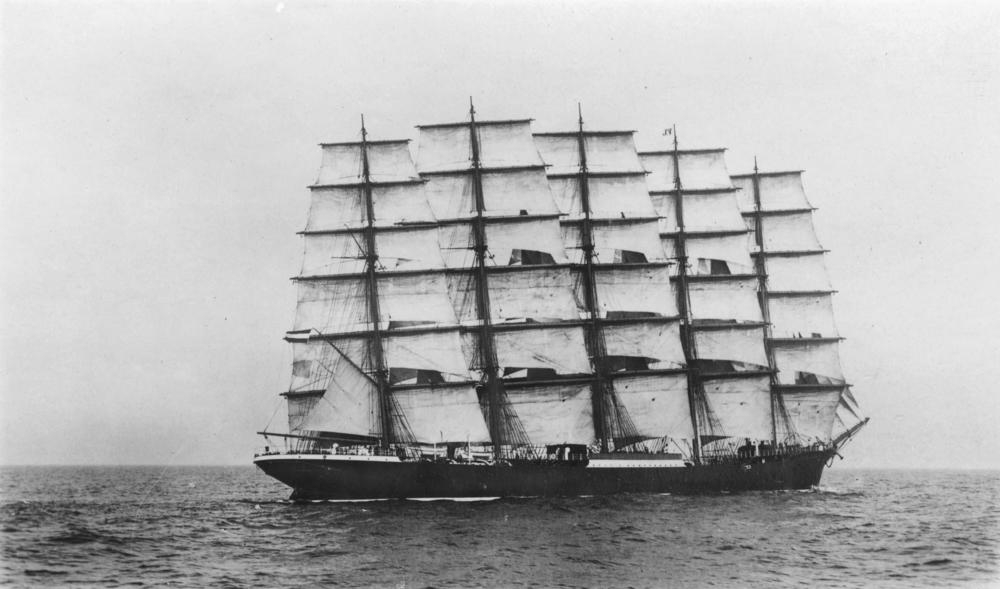
Alessandro Di Benedetto, who is also called the Crazy Italian, has a special world record on his name. He circumnavigated the world in the smallest sailboat: a 21' (6.5 m). It took him 268 days and 19 hours, which is not very fast.
But it's an impressive accomplishment, especially seen the fact that he's been dismasted around Cape Horn. To deal with his dismating, he made a junk rig that got him all the way back to France, finishing his world-record attempt successfully.
Most boats can't go faster than the speed of the wind. But some racing yachts and most multihulls can. The reason is two-fold.
The reason it's possible is that boats generate their own wind, allowing them to 'surf their own wave' so to speak, increasing their speed.
Secondly, keelboats have a displacement hull: they push the water forward, which means they have to deal with resistance, and this resistance increases when the speed increases.
But this isn't a problem with the rise of multihulls. Multihulls use flat beds instead of a keel, which means the hulls are floating on top of the water surface. This allows them to go much faster, since they don't have to deal with water resistance.
Want to know how to calculate the hull speed of any boat ? If you're like me and like to nerd out about these kinds of things, I definitely recommend to go check out my article on the average speed of sailboats (opens in new tab).
During the Anglo-Dutch wars (1652-1674) the British wanted to replace the Dutch as the dominant naval power. The Dutch admiral De Ruyter and Grand Pensionary DeWitt came up with a flag signaling system to outmaneuver the British. It was a success.
To be fair, this is more of fun trivial knowledge, and not so much a sailing fact. Consider it a bonus fact:
Ching Shih (which literally means 'widow of Zheng') was the mightiest pirate that ever lived. She had over 300 junks under her command. The ships were manned by between 20,000 - 40,000 men, women, and children. She fought major naval powers, such as the British Empire, Portuguese, and the Qing dynasty.
She's without doubt the most successful pirate ever. Unlike many others, she wasn't executed, but actually died as a free woman in her own home. Quite the story.
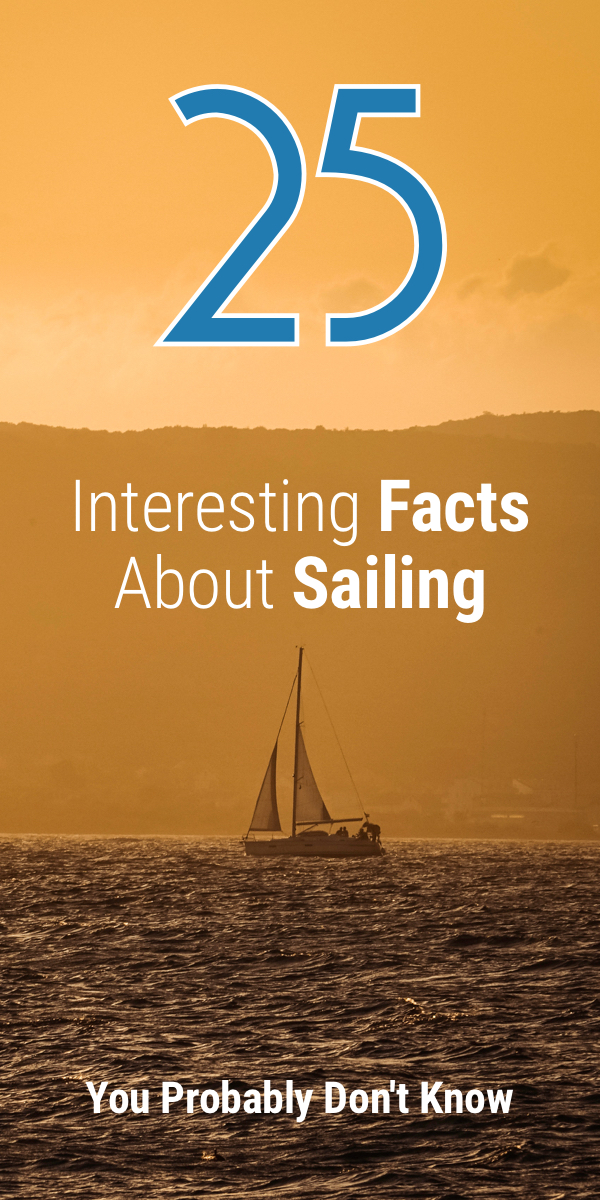
read your 25 facts. excellent, interesting, short to the point, really unknown and enlightning facts that made me curious and search more info. thanks!

Shawn Buckles
Hi Miki, thanks and great to hear you’ve enjoyed the article. You’re welcome!
Wayne Hughes
Hi Miki, Tonight we have our local small sailing club Annual Prizegiving - I am the MC - Sincere Thanks for your research and article as they will give interesting facts to be sprinkled throughout the evening.
Narrabeen Lakes Sailing Club - Sydney, Australia - 115 years old this year
Ray Bradley
Very interesting reading,with some humour thrown in. Thankyou
I JUST WANTED TO SAY I WAS DOING MY HOMEWORK AND I was sooo happy to find out I got good grades thank to this website I give it a 👍🏻
Leave a comment
You may also like, 13 reasons why sailing is better than powerboating.
Want to know why sailing trumps powerboating? In this article I'll give you 13 clear-cut reasons why it's the case - and why I'll never go back.

9 Practical Tips & Locations for Sailing the Mediterranean

10 Fascinating Fun Facts About Boats You Didn’t Know
Ahoy, fellow sea enthusiasts! Welcome to Facts Vibes. Today, we’re setting sail on a captivating journey into the world of boats. From the majestic Titanic to the humble canoe, we’ll uncover fun facts about boats that will leave you in awe of their fascinating history and design. Let’s dive in!
Content structure
Unveiling the Fascinating World of Boats: Fun Facts and Trivia
Unveiling the Fascinating World of Boats: Fun Facts and Trivia in the context of {theme}.
Most popular facts
The oldest recovered boat, known as the pesse canoe, dates back to 8040 bce and was found in the netherlands..
The oldest recovered boat, known as the Pesse canoe , dates back to 8040 BCE and was found in the Netherlands.
The Titanic, which sank in 1912, was equipped with a swimming pool, gym, and Turkish bath for its first-class passengers.
Yes, the Titanic was equipped with a swimming pool , gym , and Turkish bath for its first-class passengers.
The world’s largest cruise ship, Symphony of the Seas, features a 10-story water slide and a zip line on board.
The fastest speed recorded by a boat is
The fastest speed recorded by a boat is 511 km/h (317.6 mph) .
97 mph is a speed measurement used in transportation and sports .
6 km/h) achieved by the Spirit of Australia in
The top speed of 511 km/h ( 317.58 mph ) achieved by the Spirit of Australia in 1978 still holds the world water speed record today.
In the context of Information and facts, data security and accuracy are crucial.
The longest sea voyage made by a boat was completed by the Hokule’a, a traditional Polynesian double-hulled canoe, traveling over 60,000 nautical miles without modern navigation tools.
The longest sea voyage made by a boat was completed by the Hokule’a , a traditional Polynesian double-hulled canoe, traveling over 60,000 nautical miles without modern navigation tools.
The concept of a boat’s “port” and “starboard” sides comes from the old practice of mooring a boat with the steering oar (or “steer board”) on the right side.
The concept of a boat’s “port” and “starboard” sides comes from the old practice of mooring a boat with the steering oar (or “ steer board “) on the right side.
The USS Constitution, a wooden-hulled frigate launched in 1797, is the oldest commissioned naval vessel still afloat.
The USS Constitution is the oldest commissioned naval vessel still afloat, and it was launched in 1797.
The Chinese treasure fleet, led by admiral Zheng He in the early 15th century, consisted of massive ships, some of which were reportedly over 400 feet long.
Admiral Zheng He led the Chinese treasure fleet in the early 15th century, consisting of massive ships, some reportedly over 400 feet long.
The hydrofoil boat, which uses submerged wings to lift the hull above the water, can travel faster and with less resistance than traditional boats.
The hydrofoil boat uses submerged wings to lift the hull above the water, enabling it to travel faster and with less resistance than traditional boats.
The world’s smallest boat, the “Nano yacht,” is just 30 micrometers in length, or about 1/3 the diameter of a human hair.
The world’s smallest boat, the “Nano yacht,” is just 30 micrometers in length.
The term “yacht” comes from the Dutch word “jacht,” which originally referred to light, fast sailing vessels used by the navy to pursue pirates and other adversaries.
The term “yacht” comes from the Dutch word “ jacht ,” which originally referred to light, fast sailing vessels used by the navy to pursue pirates and other adversaries.
The Seabreacher, a type of semi-submersible boat, is designed to mimic the movements of marine animals like dolphins, sharks, and killer whales.
The first recorded instance of a steam-powered boat was by Claude de Jouffroy in 1783 with his paddle-wheel steamboat, the Pyroscaphe.
The first recorded instance of a steam-powered boat was by Claude de Jouffroy in 1783 with his paddle-wheel steamboat , the Pyroscaphe.
The boat used by Thor Heyerdahl to sail from Peru to Polynesia in 1947, the Kon-Tiki, was built using only materials and techniques available to pre-Columbian South Americans.
Yes, the boat used by Thor Heyerdahl to sail from Peru to Polynesia in 1947, the Kon-Tiki , was built using only materials and techniques available to pre-Columbian South Americans.
The Venice Simplon-Orient-Express offers a luxury train journey that includes a short boat trip across the Channel between France and England.
The Venice Simplon-Orient-Express offers a luxury train journey that includes a short boat trip across the Channel between France and England .
In conclusion, boats hold a fascinating history and are an integral part of human civilization. From their diverse designs to their crucial role in transportation and recreation, boats continue to captivate and inspire us with their remarkable capabilities on the water. Whether it’s the largest cruise ship or the smallest sailboat , these vessels symbolize our enduring relationship with the sea and underscore the timeless appeal of maritime adventures.

IMAGES
VIDEO
COMMENTS
Yachts are some of the biggest boats in the world, and they can be found in most major oceans! In this article, we’re going to take a closer look at some fun and interesting facts about yachts, so let’s dive right into it.
This exploration will clarify what sets a yacht apart from the great many categories and varieties of boats on the market, which includes a diverse array of watercraft, making the distinction between a yacht and boat clearer.
Here are some fun facts about boats that you might not have heard about. Good luck and back luck omens are different on a boat than on dry land. For instance, whistling on a boat is expected to bring upon strong winds and is therefore considered bad luck.
1. Sailboats are slow (but efficient) The average sailboat cruises at about 4-6 knots, (4-7 mph or 7-11 km/h) and has a top speed of 9 knots (10 mph or 17 km/h). It's just not that fast. That isn't to say there aren't any quick boats: they can be incredibly fast. Especially the multihulls, which have to displace a lot less water.
The world’s smallest boat, the “Nano yacht,” is just 30 micrometers in length. The term “yacht” comes from the Dutch word “jacht,” which originally referred to light, fast sailing vessels used by the navy to pursue pirates and other adversaries.
A yacht (/ jɒt /) is a sail - or motor -propelled watercraft made for pleasure, cruising, or racing. [2][3][4] There is no standard definition, though the term generally applies to vessels with a cabin intended for overnight use.